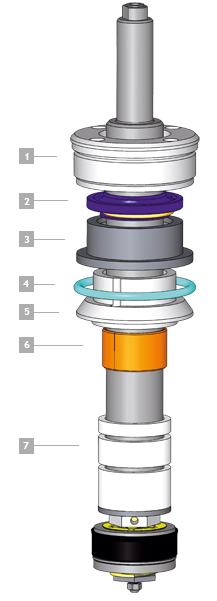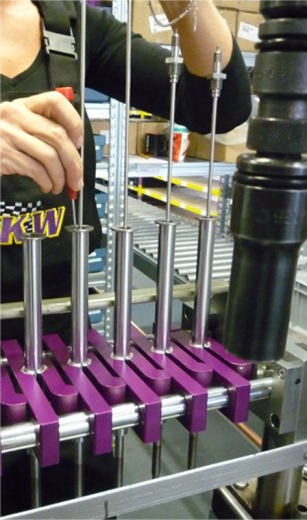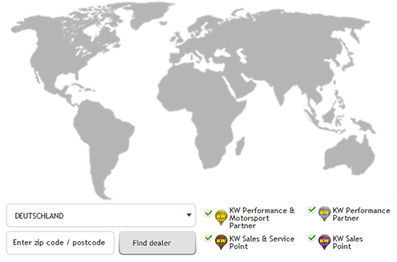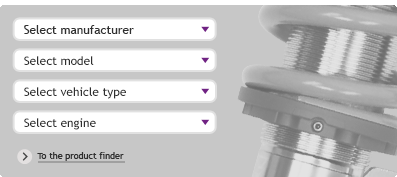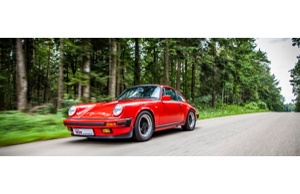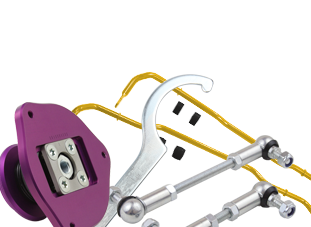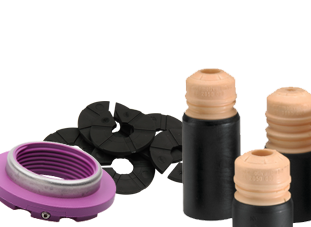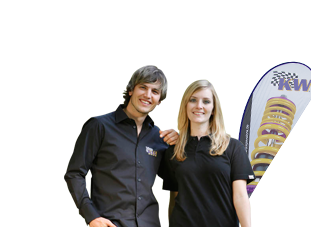KW damping and valve technology, 2-way
KW's adjustable dampening technology is offered for
a wide selection of applications and vehicle class categories.
Damper Basics - The function of a shock absorber
The vibration of the wheels, axles and chassis are reduced with the use of a "shock absorber". Therefore it would be technically correct to call the "shock absorber" a "vibration dampener". When driving over irregularities, the acting shock is absorbed by
Vibration arises from the spring wanting to give up its stored energy through a sequence of repetitive movement.
These movements are transmitted via the piston rod to the shock absorber. Here, the kinetic energy is converted to heat by hydraulic resistance in the shock absorber valve. The vibrations are reduced to an inaudible minimum.
An intact shock absorber offer:
- Reduction of body-roll during on twisty roads
- Minimized body rock during acceleration or braking
- Jumping wheels
- Improved handling when braking and swerving when braking
- Improved traction of tires
Vehicles today utilize either a twin-tube or mono-tube damper system. Both systems are constructed with a piston within an oil-filled cylinder. The piston moves the oil through valves and passages which provide resistance to the oil flow.
During the rebound phase, oil flows from the outer tube back into the inner tube. In addition to the channels located at the bottom of the valve, the oil also has to flow though the rebound valve located at the piston rod to enter the piston housing.
How a KW twin-tube shock absorber functions
When the chassis moves while driving, the oil which is lightly pressurized will be displaced by the immersion of the piston rod within the damper. The oil flows into the outer tube through the bottom valve (compression valve) which controls the flow speed
The dampers of a suspension kit converts the kinetic energy of the suspension movement into heat energy and passes it into the environment. While driving a curve in the road, the KW coilover kit functions within the vehicle providing rebound and compression

Rebound adjustment
Independent adjustable rebound damping
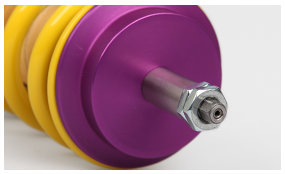
Rebound adjustment by an allen key
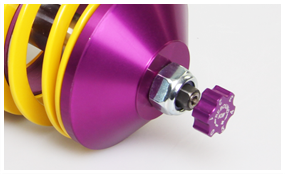
Rebound adjustment by attachable adjustment knob, when space allows
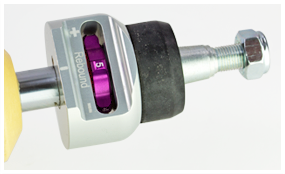
Rebound adjustment by integrated adjustment wheel
16 Clicks - Best perfomance and easy adjustment
KW Variant 2 and KW Street Comfort coilover kits provide 16 clicks of rebound adjustment.
Rebound adjustments can be made to reflect more dynamic driving characteristics or complement a change in tire selection, such as: different set of tires or winter tires.
The Variant 2 coilover provides the user more then just the height adjustability of a coilover it. The adjustable rebound feature allows the user to dial in a more sportier tighter handling characteristic or a more compliant comfortable setting suitable
Technical details of adjustable rebound damping
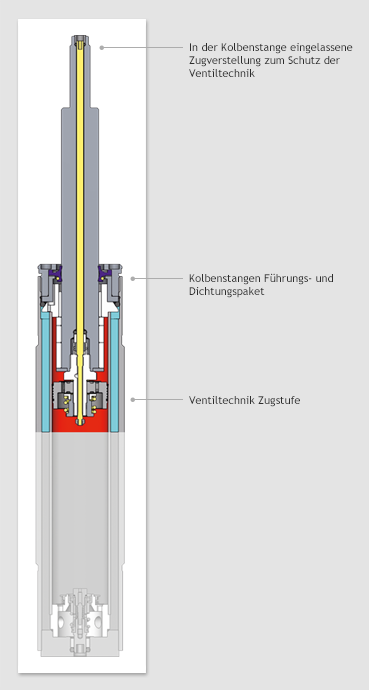
Oil flow during "hard" rebound stroke
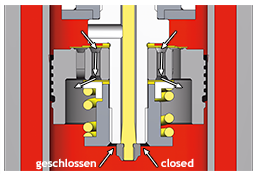
Bypass orifice with closed adjuster position. Digressive damping characteristic and the maximum achievable rebound damping. Damping is determined by the setup specific preload of the valve spring at the piston.
The result:
A firm but not a hard rebound stroke adjustment avoids rolling- and pitching motions.
Oil flow during "soft" rebound stroke
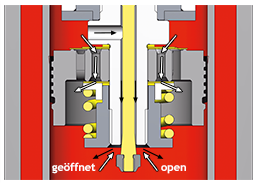
Bypass orifice with open adjuster position. Progressive damping characteristic and the minimum possible rebound damping is achieved. The bypass oil volume (black arrows) is not available anymore for the spring preloaded valve at the piston and the damping
The result:
A lower rebound damping increases the driving comfort.
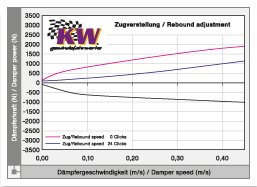
Graphic representation of the relation from damper speed (m/s) to damping force (N) when adjusting the rebound damping.

Compression adjustment
Individually adjustable compression damping
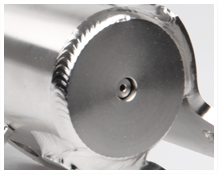
Compression adjustment by an allen key
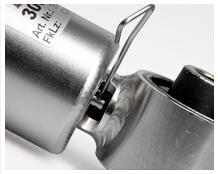
Compression with four hole adjuster, accessible through an opening
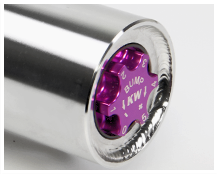
Compression adjustment by use of a integrated adjustment wheel placed at the bottom of the damper
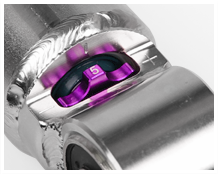
Rebound adjustment by fix integrated adjustment wheel
12-way adjustable compression damping with a denounced click feature
The KW Variant 3 and KW Clubsport coilovers are the ideal system for performance orientated driving enthusiasts who value an a wide range of dampening adjustment for their vehicles.
The adjustable independent rebound and compression damping provides an extensive range of damper tuning. This provides the enthusiast to directly effect the turn-in characteristics, tracking stability, trip grip and handling at the vehicle's limits.
The patented KW valve technology for independent rebound and compression damping allows the user to customize their KW damper setup.
Technology of compression damping in detail
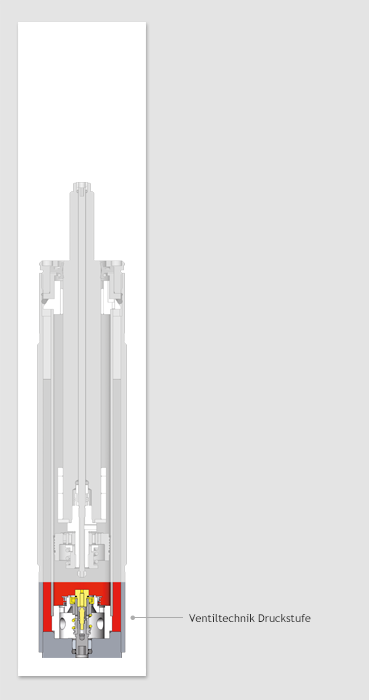
Graphic representation of the relation from damper speed (m/s) to damping force (N) when adjusting the compression damping.
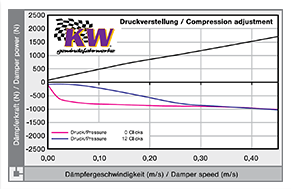
Oil flow during closed compression damping in the bottom valve
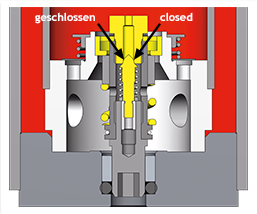
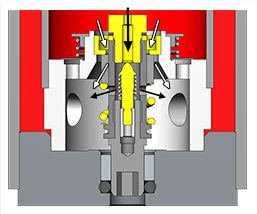
Figure 1::
Spring preloaded bypass valve of compression damping in closed state before compression stroke starts
Figure 2:
Position of the bypass valve with increasing piston rod velocity
During low piston rod velocity (black arrows), oil is fl owing over the bypass valve
The high speed compression damping (white arrows) is generated by the spring preloaded sleeve. The closed compression valve generates a progressive characteristic low-speed compression damping graph
The result:
A firmer compression stroke adjustment prevents vehicle from rolling during cornering
Oil flow during opened compression damping in the bottom valve
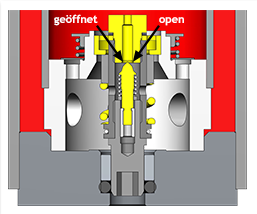
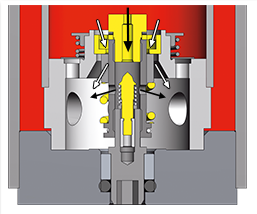
Figure 1:
Spring preloaded bypass compression valve in open state before compression stroke starts
Figure 2:
Position of the bypass valve with increasing piston rod velocity
During slower piston rod velocities (black arrows), oil is fl owing over the bypass valve
The high speed compression damping (white arrows) is generated by the spring preloaded sleeve. The opened bypass valve produces a digressive characteristic compression damping graph in Low-Speed ranges
The result:
The Low-Speed damping of this technology enables a consistent high speed compression damping. The (safety-relevant) support of the vehicle during the high speed damping range is not influenced with an opened or closed valve.

KW piston rod guiding and sealing package.
Our modular sealing system exceeds OEM standards. It can be opened easily and allows customized adjustments of the valve technology or rod / piston stroke by an aluminium nut
1. High tensile aluminum nut
2. Self-lubricated special NBR sealing
3. Clamping sleeve
4. O-ring made of temperature-resistant viton
5. Guide bushing with bleed hole
6. Special coated DU plain bearing
7. Small increment rebound spacers
